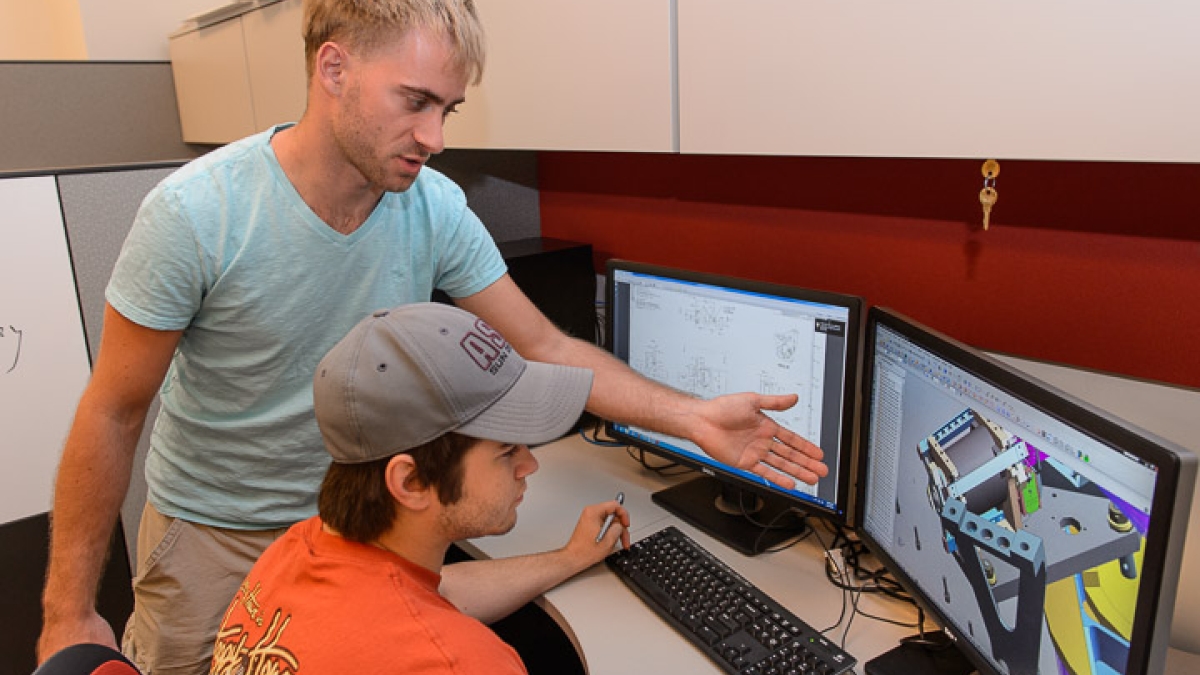Engineering students help build instrument for NASA asteroid mission

Four engineering students at Arizona State University, three of them undergraduates, are gaining practical experience by helping to build a mineral-scouting instrument that will fly on a NASA mission to an asteroid. They are drafting the detailed plans for each of the instrument's components and helping analyze its structural and thermal behavior.
The instrument is called OTES, short for OSIRIS-REx Thermal Emission Spectrometer. It is being built on ASU's Tempe campus in the Interdisciplinary Science and Technology Building 4 (ISTB4) of the School of Earth and Space Exploration. OTES is scheduled for launch in 2016 as part of NASA's OSIRIS-REx mission. ASU's Philip Christensen is the principal investigator and designer for OTES, which is a descendant of a similar instrument that went to Mars on NASA's Mars Exploration Rovers in 2004.
Three students – Ian Kubik, Tyler Lemonds and Justin Pourkaveh – are senior undergraduates in mechanical or aerospace engineering, while the fourth, Austin Pezzella, is working toward his master's degree in mechanical engineering.
They were recruited because OTES project managers and engineers were becoming overloaded with detailing work. What the project needed most was knowledgeable but entry-level help to create accurate drawings so the parts could be manufactured.
"We made a request to professor Jami Shah of the engineering school, and he spread the word among the students," says Dan Pelham, lead optical and mechanical engineer on the project. They were recruited starting in early 2013.
The design tool the OTES project uses is called NX, from Siemens PLM software. It integrates design, analysis, production and manufacturing. Siemens also provided Teamcenter, software that lets several people work on OTES components at the same time.
"We were just starting to put our computer models together, and we recruited Zoltan Farkas as lead mechanical engineer," says Pelham. "He had extensive experience with NX in his former job."
NX has proven highly useful, Pelham notes. "In particular, it includes an analysis component called NX NASTRAN, which we needed. It's an industry standard item for structural analysis."
Getting real
For the students, working on OTES represents an important step beyond the classroom. As Lemonds explains, "Most of my engineering experience has been with class work and lab exercises, and tutoring students – all very theoretical. This is real."
The nature of the job was also appealing.
"I had applied for the job because it sounded like an amazing project – and something I can look back on, and be proud of having worked on a NASA mission that took samples from an asteroid," Pezzella says. He originally expected to work on drafting with the undergraduate students. "However, I have mainly been assisting with the thermal and structural analysis."
For their part, the undergraduates begin with a 3-D computer model of each part in the instrument.
"Most of the digital design and analysis work falls on me, and I double-check it with Dan Pelham," Farkas explains. "We then turn the models over to the students for detailing."
To manufacture the parts requires precision drawings with dimensions, allowable error tolerances, and specifications for things such as materials, surface finishn and paint. The students' job is to use NX to create the manufacturing drawings from the computer models. They also work from drawings from the earlier Mars-going version of OTES.
"The drawing reflects how a part is going to be made," says Kubik. "If you don't have any drafting experience, its difficult to know what needs to be incorporated into the drawing, and you can easily overlook the guy who's going to have to make it."
All the students hope that working on the OTES project will be a boost when they graduate and look for jobs.
"Industry uses drafting a lot, and employers like to see it in your resumé," Pourkaveh says. "You have all these kids graduating and they sit down at a computer – and they don't know how to draw anything. It's good if you can get that kind of experience in college. It gives you a leg up."
As always, real-world experience is critical.
"You can be the best engineer in the world and design the most awesome 3-D model," says Lemonds. "But if you can't communicate with the machinist who'll fabricate it – it's just a digital model."
After the students have finished with the drawings, they go through another round of checks with Farkas and Pelham. Then the drawings are sent out for manufacturing.
"It's unbelieveable how user-friendly this is. It has all the tools you need in a single package," says Kubik.
Into deep space
After OSIRIS-REx launches in 2016, NASA's flight plan calls for the spacecraft to rendezvous with asteroid Bennu (1999 RQ36) in 2018 and spend about a year orbiting and surveying its surface.
After mission scientists decide the best place to go to, OSIRIS-REx will collect the sample from the asteroid's surface and send it back to Earth, with the sample arriving in 2023. OTES plays a key role in choosing the right place to sample.
"OTES is the first complex piece of electro-optical space hardware to be built at ASU," says Christensen. He is a Regents' Professor of geological sciences in the School of Earth and Space Exploration, part of the College of Liberal Arts and Sciences. "This is a great step forward for ASU and for students involved in engineering for science."
For the students, there's another plus to working on the OTES project. Unlike a typical aerospace company, it's not a gigantic organization.
"The team here is really small," says Pourkaveh. "You get to see the whole picture and participate in every part of the process."